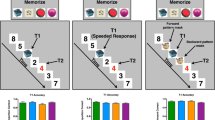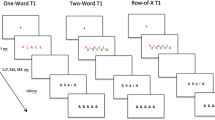Abstract
Perception of the second of two targets (T1, T2) displayed in rapid sequence is impaired if it comes shortly after the first (attentional blink, AB). In an exception, known as Lag-1 sparing, T2 is virtually unimpaired if it is presented directly after T1. Three experiments examined the seemingly inconsistent findings that Lag-1 sparing occurs in accuracy but Lag-1 deficit occurs in RT. Experiment 1 pointed to masking of T2 as the critical factor. When T2 was not masked, the results replicated the conventional findings. The novel finding was that Lag-1 sparing occurred in RT, provided that T2 was masked. An account was provided by a psychological refractory period-based model in which processing was said to occur in two broadly sequential stages: stimulus selection and response planning. Experiments 2 and 3 tested predictions from the PRP-based model regarding Lag-1 sparing/Lag-1 deficit. In Experiment 2, we increased T2 salience, notionally reducing the duration of the T2 selection stage, with corresponding reduction in Lag-1 sparing. In Experiment 3, we manipulated the compatibility between the T1 stimulus and the response to notionally decrease/increase the duration of the T1 response-planning stage with corresponding increment/decrement in Lag-1 sparing. The results of both experiments confirmed predictions from the PRP-based model.







Similar content being viewed by others
Notes
We thank an anonymous reviewer for suggesting the inclusion of this summary.
References
Akyürek, E. G., Eshuis, S. A., Nieuwenstein, M. R., Saija, J. D., Başkent, D., & Hommel, B. (2012). Temporal target integration underlies performance at lag 1 in the attentional blink. Journal of Experimental Psychology: Human Perception and Performance, 38(6), 1448–1464.
Broadbent, D. E., & Broadbent, M. H. (1987). From detection to identification: Response to multiple targets in rapid serial visual presentation. Attention, Perception, & Psychophysics, 42, 105–113.
Chun, M. M., & Potter, M. C. (1995). A two-stage model for multiple target detection in rapid serial visual presentation. Journal of Experimental Psychology: Human Perception and Performance, 21, 109–127.
Craft, J. L., & Simon, J. R. (1970). Processing symbolic information from a visual display: interference from an irrelevant directional cue. Journal of Experimental Psychology, 83, 415–420.
Dell’Acqua, R., Pierre, J., Pascali, A., & Pluchino, P. (2007). Short-term consolidation of individual identities leads to Lag-1 sparing. Journal of Experimental Psychology: Human Perception and Performance, 33(3), 593–609.
Di Lollo, V., Kawahara, J., Ghorashi, S. M. S., & Enns, J. T. (2005). The attentional blink: Resource depletion or temporary loss of control? Psychological Research Psychologische Forschung, 69, 191–200.
Eriksen, C. W., & Eriksen, B. A. (1979). Target redundancy in visual search: Do repetitions of the target within the display impair processing? Attention, Perception, & Psychophysics, 26, 195–205.
Fortier-Gauthier, U., Dell’Acqua, R., & Jolicœur, P. (2013). The “red-alert” effect in visual search: Evidence from human electrophysiology. Psychophysiology, 50, 671–679.
Ghorashi, S., Enns, J. T., Spalek, T. M., & Di Lollo, V. (2009). Spatial cuing does not affect the magnitude of the attentional blink. Attention, Perception, & Psychophysics, 71, 989–993.
Ghorashi, S. M. S., Smilek, D., & Di Lollo, V. (2007). Visual search is postponed during the attentional blink until the system is suitably reconfigured. Journal of Experimental Psychology: Human Perception and Performance, 33, 124–136.
Giesbrecht, B., & Di Lollo, V. (1998). Beyond the attentional blink: Visual masking by object substitution. Journal of Experimental Psychology: Human Perception and Performance, 24, 1454–1466.
Hommel, B., & Akyürek, E. G. (2005). Lag-1 sparing in the attentional blink: Benefits and costs of integrating two events into a single episode. The Quarterly Journal of Experimental Psychology Section A, 58(8), 1415–1433.
Jolicœur, P. (1999). Concurrent response-selection demands modulate the attentional blink. Journal of Experimental Psychology: Human Perception and Performance, 25, 1097–1113.
Jolicœur, P., & Dell’Acqua, R. (1998). The demonstration of short-term consolidation. Cognitive Psychology, 36, 138–202.
Kawahara, J. I., Di Lollo, V., & Enns, J. T. (2001). Attentional requirements in visual detection and identification: Evidence from the attentional blink. Journal of Experimental Psychology: Human Perception and Performance, 27, 969–984.
Kawahara, J. I., Zuvic, S. M., Enns, J. T., & Di Lollo, V. (2003). Task switching mediates the attentional blink even without backward masking. Perception & Psychophysics, 65, 339–351.
Lagroix, H., Di Lollo, V., & Spalek, T. (2016). Lag-1 sparing in accuracy and reaction time: The importance of masking. Journal of Vision, 16, 595.
Lagroix, H. E. P., Grubert, A., Spalek, T. M., Di Lollo, V., & Eimer, M. (2015). Visual search is postponed during the period of the AB: An event-related potential study. Psychophysiology, 52, 1031–1038.
Lagroix, H. E. P., Patten, J. W., Di Lollo, V., & Spalek, T. M. (2016). Perception of temporal order during the attentional blink: Using stimulus salience to modulate prior entry. Attention, Perception, & Psychophysics, 78, 1064–1073.
Lappin, J. S. (1978). The relativity of choice behavior and the effect of prior knowledge on the speed and accuracy of recognition. In N. J. Castellan & F. Restle (Eds.), Cognitive theory (Vol. 3, pp. 139–168). Hillsdale: Erlbaum.
Marti, S., King, J.-R., & Dehaene, S. (2015). Time-resolved decoding of two processing chains during dual-task interference. Neuron, 88, 1297–1307.
Marti, S., Sigman, M., & Dehaene, S. (2012). A shared cortical bottleneck underlying attentional blink and psychological refractory period. NeuroImage, 59, 2883–2898.
Nieuwenhuis, S., Gilzenrat, M. S., Holmes, B. D., & Cohen, J. D. (2005). The role of the locus coeruleus in mediating the attentional blink: a neurocomputational theory. Journal of Experimental Psychology: General, 134, 291–307.
Olivers, C. N., & Meeter, M. (2008). A boost and bounce theory of temporal attention. Psychological Review, 115, 836.
Pashler, H. (1994). Dual-task interference in simple tasks: data and theory. Psychological Bulletin, 116, 220–244.
Potter, M. C., Chun, M. M., Banks, B. S., & Muckenhoupt, M. (1998). Two attentional deficits in serial target search: the visual attentional blink and an amodal task-switch deficit. Journal of Experimental Psychology: Learning, Memory, and Cognition, 24, 979–992.
Potter, M. C., & Levy, E. I. (1969). Recognition memory for a rapid sequence of pictures. Journal of experimental psychology, 81, 10–15.
Raymond, J. E., Shapiro, K. L., & Arnell, K. M. (1992). Temporary suppression of visual processing in an RSVP task: An attentional blink? Journal of Experimental Psychology: Human Perception and Performance, 18, 849–860.
Reeves, A., & Sperling, G. (1986). Attention gating in short-term visual memory. Psychological Review, 93, 180–206.
Santee, J. L., & Egeth, H. E. (1982). Do reaction time and accuracy measure the same aspects of letter recognition? Journal of Experimental Psychology: Human Perception and Performance, 8, 489–501.
Sigman, M., & Dehaene, S. (2008). Brain mechanisms of serial and parallel processing during dual-task performance. Journal of Neuroscience, 28, 7585–7598.
Smith, E., E., & Spoehr, K. T. (1974). The perception of printed English: A theoretical perspective. In B. H. Kantowitz (Ed.), Human information processing: Tutorials in perception and cognition. Hillsdale: Erlbaum.
Spalek, T. M., Falcon, L. J., & Di Lollo, V. (2006). Attentional blink and attentional capture: Endogenous versus exogenous control over paying attention to two important events in close succession. Perception & Psychophysics, 68, 674–684.
Telford, C. W. (1931). The refractory phase of voluntary and associative responses. Journal of Experimental Psychology, 14, 1.
Valle-Inclán, F. (1996). The locus of interference in the Simon effect: An ERP study. Biological Psychology, 43, 147–162.
Visser, T. A., Bischof, W. F., & Di Lollo, V. (1999). Attentional switching in spatial and nonspatial domains: Evidence from the attentional blink. Psychological Bulletin, 125, 458–469.
Wyble, B., Bowman, H., & Nieuwenstein, M. (2009). The attentional blink provides episodic distinctiveness: Sparing at a cost. Journal of Experimental Psychology: Human Perception and Performance, 35, 787–807.
Wyble, B., Potter, M. C., Bowman, H., & Nieuwenstein, M. (2011). Attentional episodes in visual perception. Journal of Experimental Psychology: General, 140, 488–505.
Acknowledgements
This work was supported by a Canadian Foundation for Innovation New Opportunities Grant and a grant from the British Columbia Knowledge Development Fund to TMS, by Discovery Grants from the Natural Sciences and Engineering Research Council of Canada (NSERC) to TMS and VDL, and by an NSERC Alexander Graham Bell Canada Graduate Scholarship and NSERC Postdoctoral Fellowship awarded to HEPL. The datasets analyzed during the current study are available from the corresponding author on reasonable request.
Author information
Authors and Affiliations
Corresponding author
Rights and permissions
About this article
Cite this article
Lagroix, H.E.P., Di Lollo, V. & Spalek, T.M. The attentional blink: why does Lag-1 sparing occur when the dependent measure is accuracy, but Lag-1 deficit when it is RT?. Psychological Research 83, 1778–1797 (2019). https://doi.org/10.1007/s00426-018-1026-3
Received:
Accepted:
Published:
Issue Date:
DOI: https://doi.org/10.1007/s00426-018-1026-3




